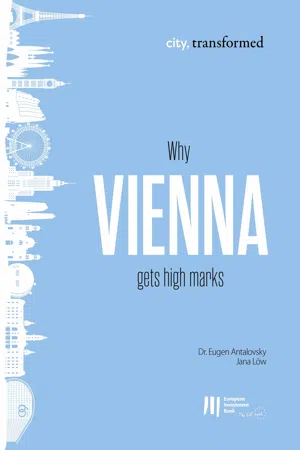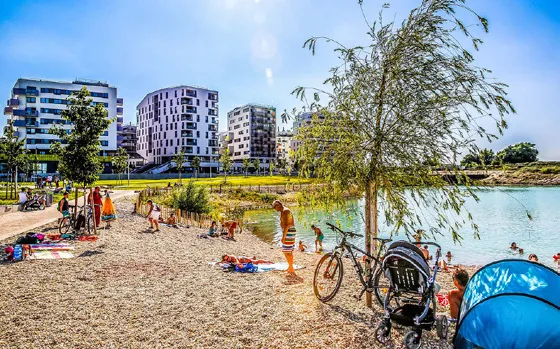
This is a test
- 26 pages
- English
- ePUB (mobile friendly)
- Available on iOS & Android
eBook - ePub
Why Vienna gets high marks
Book details
Book preview
Table of contents
Citations
About This Book
This essay reviews the political circumstances and strategic orientations of Vienna's comprehensive urban development policy, and how the EIB's investments facilitated key projects and supported Vienna's process of urban modernisation. Urban development in Vienna took place in four cycles, which are characterised by distinctive internal and external conditions and opportunities. Each prompted different levels of EIB engagement.
Frequently asked questions
At the moment all of our mobile-responsive ePub books are available to download via the app. Most of our PDFs are also available to download and we're working on making the final remaining ones downloadable now. Learn more here.
Both plans give you full access to the library and all of Perlego’s features. The only differences are the price and subscription period: With the annual plan you’ll save around 30% compared to 12 months on the monthly plan.
We are an online textbook subscription service, where you can get access to an entire online library for less than the price of a single book per month. With over 1 million books across 1000+ topics, we’ve got you covered! Learn more here.
Look out for the read-aloud symbol on your next book to see if you can listen to it. The read-aloud tool reads text aloud for you, highlighting the text as it is being read. You can pause it, speed it up and slow it down. Learn more here.
Yes, you can access Why Vienna gets high marks by Eugen Antalovsky, Jana Löw, European Investment Bank in PDF and/or ePUB format, as well as other popular books in Economics & Public Finance. We have over one million books available in our catalogue for you to explore.
Information
Austria’s capital transformed from a peripheral, declining outpost of the Cold War to a city that consistently ranks top of global quality of life surveys. Here’s how Vienna turned a series of major economic and geopolitical challenges to its advantage.
Introduction
In the mid-1980s, when Vienna presented its first urban development plan, the city government expected the population to decline and foresaw serious challenges for its urban economy. However, geopolitical transformations prompted a fresh wave of immigration to Vienna, so the city needed to adapt fast and develop new initiatives. A new spirit of urban development emerged.
Vienna’s remarkable migration-driven growth took place in three phases:
- first, the population grew rapidly between 1989 and 1993
- then it grew again between 2000 and 2006
- and finally from 2010 until today the population has been growing steadily and swiftly, by on average around 22,000 people per year
- This means an addition of nearly 350,000 inhabitants since 1989.
After these 30 years of increased population, Vienna is a growing, dynamic and successful global city in Central and South Eastern Europe. Due to consistent long-term oriented improvements, Vienna is well-placed to continue its success as an attractive, prosperous and inclusive metropolis. Mercer’s “Quality of Living Survey 2018” ranks Vienna highest for quality of living in the world for the ninth year in a row. This award acknowledges the professional and integrated management of the city. It also reflects the development of creative, innovative and sustainable municipal policies and initiatives.

Many of the impulses for the successful recovery of the city were realised by means of projects and urban programmes that received key investments from the European Investment Bank.
This essay reviews the political circumstances and strategic orientations of Vienna’s comprehensive urban development policy, and how the EIB’s investments facilitated key projects and supported Vienna’s process of urban modernisation. Urban development in Vienna took place in four cycles, which are characterised by distinctive internal and external conditions and opportunities. Each prompted different levels of EIB engagement:
The first cycle is shaped profoundly by the collapse of the communist system and a total change in the geopolitical conditions affecting Vienna’s development. Vienna evolved from a declining city at the periphery of Western Europe to a growing city in the heart of a renewed Europe, facing fundamental challenges in economic and urban development.
In the second cycle Vienna was a city in transition, as it sought to define its new position in the European Union on the one hand and its role as a city bordering the EU’s Central and Eastern European neighbours on the other. In this period, the city government made strategic decisions for long-term urban development in this new environment: the issue of sustainability gained importance and the city carried out comprehensive action for affordable housing and urban renewal.
In the third cycle Vienna coped with the challenges of a rapidly growing city and the implementation of large-scale projects to promote Vienna on an international level and enhance the attractiveness of the city as a knowledge hub and as an integrated inclusive city. This is the period where the EIB provided the majority of its focused investments.
The fourth cycle stands for enhancing the international and economic competitiveness of the city on the one hand and for implementing a full smart city strategy that cuts across all areas of urban policy, on the other. The city government and its citizens are faced with the challenge of the large influx of refugees and the shift in the political debate against “open cities”.
Timeline of developments (population, political incidents, urban planning, performance cycles)

Timeline of EIB investment in Vienna and the metropolitan region (mentioned years: dates of signature)

Cycle 1: 1989-1995
Vienna at a crossroads
The year of the fall of the Iron Curtain was of fundamental historical importance for Europe and the geopolitical system. It was also the beginning of a completely new era of development opportunities for Vienna. In 1989, Vienna was a declining metropolis. It retained its exceptional cultural and architectural heritage, but it also had to contend with a rapidly ageing population, economic stagnation and a certain degree of “progress aversion”. Vienna tended to view itself above all as a vulnerable outpost of the West, in close proximity to the menace of the “Eastern Bloc”. After 1989, the city found itself suddenly in a completely different situation. The Austrian capital became a logical “gateway to the East” for numerous international enterprises and the first point of contact for people from the Eastern and South Eastern European transition countries.
Although the Iron Curtain was entrenched in people’s minds – and today we know that it took a very long time to overcome most of these mental barriers – its collapse unlocked unexpected power and ideas. By the summer of 1989, the City of Vienna had already commissioned a study on the effects and impacts of open borders for the development of Vienna. Beyond that, the study discussed a “growing city” for the first time. From this moment onwards, “growth” became a key term of political and planning debates for the decades to come, representing a fundamental paradigm shift.
The Urban Development Plan for Vienna of the year 1984 (STEP 1984) predicted an ongoing decline in population, a very weak economic performance and a reduction of available public finances coinciding with growing demands on those public finances. The plan focused on a shrinking city, infrastructural and environmental improvement, and “soft urban renewal” for a better quality of life. This included a publicly financed refurbishment programme to preserve Vienna’s historical housing.
The urban development plan 1994 responds to a fundamental change
All subsequent strategy documents, in particular the Urban Development Guidelines 1991 and the Urban Development Plan 1994 (STEP 1994), were dominated by the core questions of
- how to cope with population growth
- how to use it to develop Vienna into an open minded and economically competitive metropolis in the heart of Europe
- how to prepare the city for the 21st century in a sustainable and environmentally friendly way.
The STEP 1994 notably integrated several important concepts and ideas into Vienna’s development plans for the first time: The concept of the international competitiveness of cities, the importance of economy in the context of urban development, the visio...
Table of contents
- 1. Introduction
- Cycle 1: 1989-1995 Vienna at a crossroads
- Cycle 2: 1996-2005 Positioning Vienna in a changing Europe
- Cycle 3: 2006-2010 Large-scale investment boosts Vienna’s competitiveness
- Cycle 4: 2011-present Balancing growth, the influx of refugees and smart urban development
- Annex EIB loans in Vienna and the metropolitan area
- References